Groundwater–River Water Interaction in an Urban Setting (Rome, Italy) Using a Multi-Method Approach (Hydrogeological and Radon Analyses)
Abstract
1. Introduction
2. Study Area
2.1. Geological Setting
2.2. Hydrogeological Setting
3. Materials and Methods
3.1. Flow Measurements with Electromagnetic Induction Current Meters
3.2. Geochemical Determination
4. Results
4.1. Hydrological Data
4.2. Hydrochemical and Radon Data
5. Discussion
- The increase in discharge observed between stations 1A and 2A during both measurement campaigns is significant because the differences between the discharge data (52 L/s and 25 L/s, respectively, in June 2024 and March 2025) are higher than the relative uncertainties (from 9 to 14 L/s in June 2024 and from 2.4 to 2.9 L/s in March 2025). This could be related to the geometry of the regional aquifer in this specific sector of the valley (Figure 8). A gradual thickness decrease in the regional aquifer, due to the bedding of the underlying less permeable deposits of the Alban basal volcanic complex and the incremental thickness of the alluvial deposits, lead to a groundwater discharge into the surface fluvial network, resulting in a flow rate increase along this segment of the river.
- The discharge variation between sections 2A and 6A falls in the estimated 10% measurement error; this suggests a nearly constant discharge between these sections and contrasts with [8], which reported a progressive increase in the Almone River discharge in this part of the valley.
- The contribution of the two tributaries was subtracted from the Almone River discharge data at corresponding confluence points (between 6A and 7A measurement points for “Marrana sinistra” and between 10A and 11A stations for “Marrana destra”). When these contributions were eliminated (Figure 8), an almost constant flow rate trend was observed in June 2024, while increasing discharge data were recorded in March 2025 between measurement points 6A and 11A. This increase is significant because the differences (from 12 to 32 L/s) between consecutive measurements along the river valley are basically higher than relative uncertainties (ranging from 3 to 5 L/s). This increased discharge is most likely due to enhanced runoff or subsurface flow contributions determined by the rainy period preceding the March 2025 survey, as shown by hydrometeorological data in [36]. Tor Marancia station (only 1 km from the Caffarella area) recorded a cumulative rainfall of 413 mm in the months preceding the March 2025 campaign and 246 mm for the period preceding the June 2024 campaign. Similar information was given by the Lago di Albano station (located near the area of Almone’s spring) with 513 mm and 340 mm of rainfall preceding the June 2024 and March 2025 surveys, respectively. It is worth noting that seasonality and seasonal extremes in dry vs. wet years might influence river–groundwater relationships, with rainy periods enhancing the increase in river discharge from station 6a to 11A where the alluvial body is progressively thicker or dry years leading to no significant input of subsurface water downstream. More sampling campaigns repeated over multiple years will enhance the robustness of these preliminary findings.
6. Conclusions
Author Contributions
Funding
Data Availability Statement
Acknowledgments
Conflicts of Interest
Appendix A
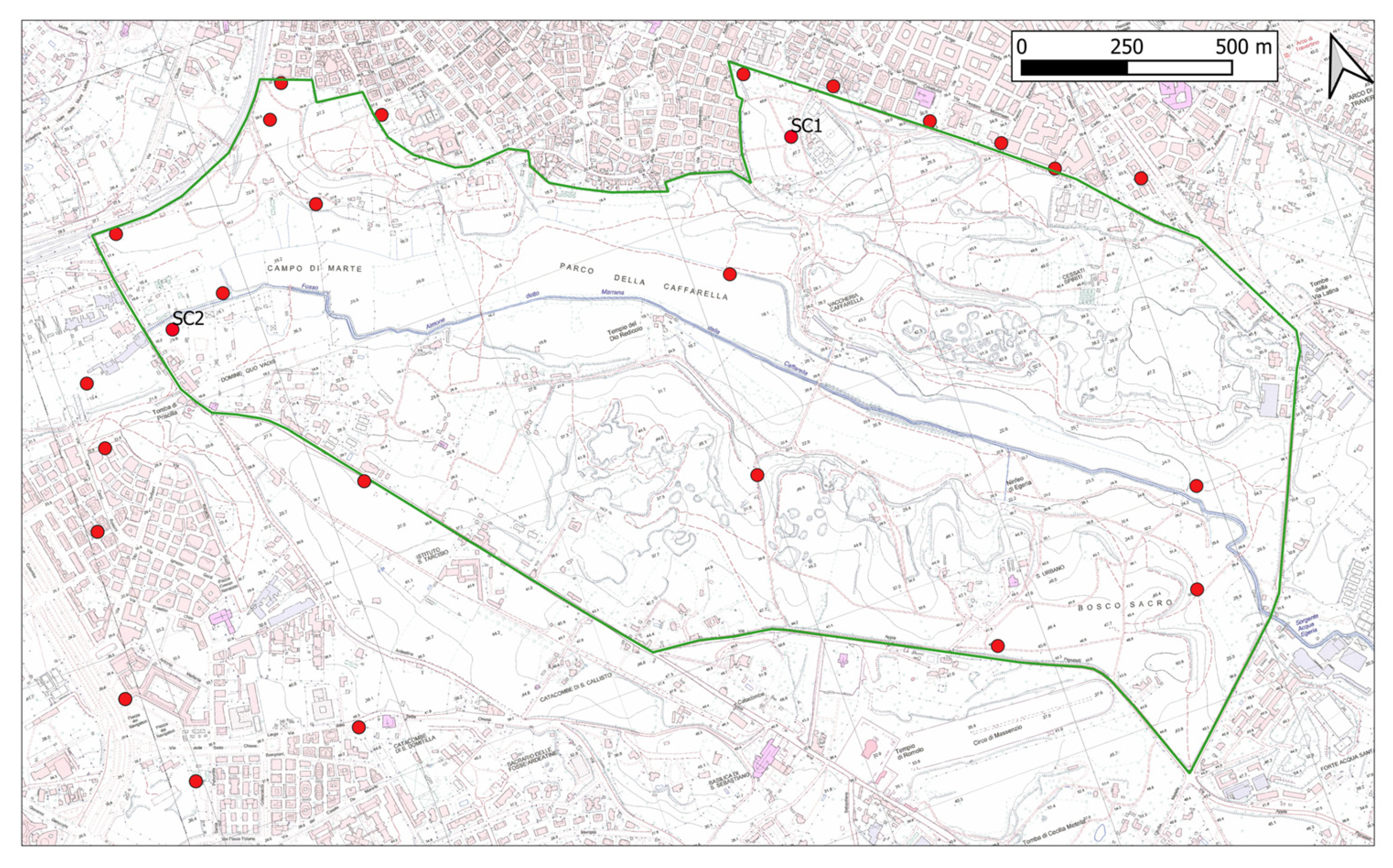
References
- Boano, F.; Camporeale, C.; Revelli, R.; Ridolfi, L. Sinuosity-driven hyporheic exchange in meandering rivers. Geophys. Res. Lett. 2006, 33, L18406. [Google Scholar] [CrossRef]
- Irvine, D.J.; Singha, K.; Kurylyk, B.L.; Briggs, M.A.; Sebastian, Y.; Tait, D.R.; Helton, A.M. Groundwater-Surface water interactions research: Past trends and future directions. J. Hydrol. 2024, 644, 132061. [Google Scholar] [CrossRef]
- Hare, D.K.; Helton, A.M.; Johnson, Z.C.; Lane, J.W.; Briggs, M.A. Continental-scale analysis of shallow and deep groundwater contributions to streams. Nat. Commun. 2021, 12, 1450. [Google Scholar] [CrossRef]
- Benz, S.A.; Irvine, D.J.; Rau, G.C.; Bayer, P.; Menberg, K.; Blum, P.; Jamieson, R.C.; Griebler, C.; Kurylyk, B.L. Global groundwater warming due to climate change. Nat. Geosci. 2024, 17, 545–551. [Google Scholar] [CrossRef]
- Del Vecchia, A.G.; Shanafield, M.; Zimmer, M.A.; Busch, M.H.; Krabbenhoft, C.A.; Stubbington, R.; Kaiser, K.E.; Burrows, R.M.; Hosen, J.; Datry, T.; et al. Reconceptualizing the hyporheic zone for nonperennial rivers and streams. Freshw. Sci. 2022, 41, 167–182. [Google Scholar] [CrossRef]
- Grischek, T.; Foley, A.; Schoenheinz, D.; Gutt, B. Effects of Interaction between Surface Water and Groundwater on Groundwater Flow and Quality Beneath Urban Areas. In Current Problems of Hydrogeology in Urban Areas, Urban Agglomerates and Industrial Centres; Howard, K.W.F., Israfilov, R.G., Eds.; Nato Science Series; Springer: Dordrecht, The Netherlands, 2002; Volume 8. [Google Scholar]
- Chiudioni, F.; Marcheggiani, S.; Puccinelli, C.; Trabace, T.; Mancini, L. Heavy metals in tributaries of Tiber River in the urban area of Rome (Italy). Heliyon 2024, 10, e33964. [Google Scholar] [CrossRef] [PubMed]
- La Vigna, F.; Mazza, R.; Amanti, M.; Di Salvo, C.; Petitta, M.; Pizzino, L.; Pietrosante, A.; Martarelli, L.; Bonfà, I.; Capelli, G.; et al. Groundwater of Rome. J. Maps 2016, 12, 88–93. [Google Scholar] [CrossRef]
- Adyasari, D.; Dimova, N.T.; Dulai, H.; Gilfedder, B.S.; Cartwright, I.; McKenzie, T.; Fuleky, P. Radon-222 as a groundwater discharge tracer to surface waters. Earth-Sci. Rev. 2023, 238, 104321. [Google Scholar] [CrossRef]
- Kendall, C.; McDonnell, J.J. Isotope Tracers in Catchment Hydrology, 1st ed.; Elsevier: Amsterdam, The Netherlands, 1999; ISBN 9780080929156. [Google Scholar]
- Cecil, L.D.; Green, J.R. Radon-222. In Environmental Tracers in Subsurface Hydrology; Springer: Berlin/Heidelberg, Germany, 2000; pp. 175–194. [Google Scholar]
- Burnett, W.C.; Dulaiova, H. Radon as a tracer of submarine groundwater discharge into a boat basin in Donnalucata. Cont. Shelf Res. 2006, 26, 862–873. [Google Scholar] [CrossRef]
- Cook, P.G. Estimating groundwater discharge to rivers from river chemistry surveys. Hydrol. Process. 2013, 27, 3694–3707. [Google Scholar] [CrossRef]
- Burnett, W.C.; Bokuniewicz, H.; Huettel, M.; Moore, W.S.; Taniguchi, M. Groundwater and pore water inputs to the coastal zone. Biogeochemistry 2003, 66, 3–33. [Google Scholar] [CrossRef]
- Corbett, D.R.; Burnett, W.C.; Cable, P.H.; Clark, S.B. Radon tracing of groundwater input into Par Pond, Savannah River Site. J. Hydrol. 1997, 203, 209–227. [Google Scholar] [CrossRef]
- Burnett, W.C.; Chanyotha, S.; Wattayakorn, G.; Taniguchi, M.; Umezawa, Y.; Ishitobi, T. Underground sources of nutrient contamination to surface waters in Bangkok, Thailand. Sci. Total Environ. 2009, 407, 3198–3207. [Google Scholar] [CrossRef]
- Partington, D.; Knowling, M.J.; Simmons, C.T.; Cook, P.G.; Xie, Y.; Iwanaga, T.; Bouchez, C. Worth of hydraulic and water chemistry observation data in terms of the reliability of surface water-groundwater exchange flux predictions under varied flow conditions. J. Hydrol. 2020, 590, 125441. [Google Scholar] [CrossRef]
- Zhou, Z.; Cartwright, I. Using geochemistry to identify and quantify the sources, distribution, and fluxes of baseflow to an intermittent river impacted by climate change: The upper Wimmera River, Southeast Australia. Sci. Total Environ. 2021, 801, 149725. [Google Scholar] [CrossRef]
- Ellins, K.K.; Roman-Mas, A.; Lee, R. Using 222Rn to examine groundwater/surface discharge interaction in the Rio Grande de Manati, Puerto Rico. J. Hydrol. 1990, 115, 319–341. [Google Scholar] [CrossRef]
- Genereux, D.P.; Hemond, H.F. Naturally occurring Radon 222 as a tracer for streamflow generation: Steady state methodology and field example. Water Resour. Res. 1990, 26, 3065–3075. [Google Scholar]
- Patacca, E.; Scandone, P. Post-Tortonian Mountain building in the Apennines. The role of the passive sinking of a relic lithospheric slab. In The Lithosphere in Italy; Boriani, A., Bonafede, M., Piccardo, G.B., Vai, G.B., Eds.; Atti dei Convegni Lincei; Accademia Nazionale dei Lincei: Rome, Italy, 1989; Volume 80, pp. 157–176. [Google Scholar]
- Cipollari, P.; Cosentino, D. Miocene unconformities in the Central Apennines: Geodynamic significance and sedimentary basin evolution. Tectonophysics 1995, 252, 375–389. [Google Scholar] [CrossRef]
- Cosentino, D.; Asti, R.; Nocentini, M.; Gliozzi, E.; Kotsakis, T.; Mattei, M.; Esu, D.; Spadi, M.; Tallini, M.; CifellI, F.; et al. New insights into the onset and evolution of the central Apennine extensional intermontane basins based on the tectonically active L’Aquila Basin (central Italy. Geol. Soc. Am. Bull. 2017, 129, 1314–1336. [Google Scholar] [CrossRef]
- Funiciello, R.; Giordano, G. La nuova carta geologica di Roma: Litostratigrafia e organizzazione stratigrafica. La geologia di Roma. Dal Cent. Stor. Alla Perif. 2008, 80, 39–85. [Google Scholar]
- Moscatelli, M.; Piscitelli, S.; Piro, S.; Stigliano, F.; Giocoli, A.; Zamuner, D.; Marconi, F. Integrated geological and geophysical investigations to characterize the anthropic layer of the Palatine hill and Roman Forum (Rome, Italy). Bull. Earthquake Eng. 2014, 12, 1319–1338. [Google Scholar] [CrossRef]
- Karner, D.B.; Marra, F.; Renne, P. The history of Monti Sabatini and Alban Hills volcanoes: Groundwork for Assessing Volcanic-Tectonic Hazards for Rome. J. Volcanol. Geoth. Res. 2001, 107, 185–219. [Google Scholar] [CrossRef]
- Capelli, G.; Mastrorillo, L.; Mazza, R.; Petitta, M.; Baldoni, T.; Bonzano, F.; Cascone, D.; Di Salvo, C.; La Vigna, F.; Taviani, S.; et al. Carta Idrogeologica del Territorio della Regione Lazio, Scala 1:100.000, 4 Sheets; Regione Lazio; SELCA Firenze: Firenze, Italy, 2012. [Google Scholar]
- Mazzini, I.; Gliozzi, E.; Abati, S.; Callori di Vignale, C.; Capelli, G.; Ceschin, S.; Faranda, C.; Mazza, R.; Piccari, F.; Rossetti, C.; et al. Field-Trip Guide, Proceedings of the 17th International Symposium on Ostracoda “Back to the Future”, Rome, Italy, 22–26 July 2013; Università degli Studi Roma Tre: Rome, Italy, 2013. [Google Scholar]
- Pizzino, L.; Cinti, D.; Procesi, M.; Sciarra, A. Preliminary chemical characterization of groundwater in the Rome Municipality. Ital. J. Groundw. 2015, 4, 47–57. [Google Scholar] [CrossRef][Green Version]
- Tuccimei, P.; Lane-Smith, D.; Galli, G.; Lucchetti, C.; De Simone, G.; Simko, J.; Cook, I.; Bond, C.E. Our pet project: An unlimited supply of big and small water sample vials for the assay of radon in water. J. Radioanal. Nucl. Chem. 2015, 307, 2277–2280. [Google Scholar] [CrossRef]
- Lucchetti, C.; Briganti, A.; Semenza, D.; Castelluccio, M.; Galli, G.; Soligo, M.; Tuccimei, P. Testing the radon-in-water probe set-up for the measurement of radon in water bodies. Radiat. Meas. 2019, 128, 106179. [Google Scholar]
- De Simone, G.; Lucchetti, C.; Galli, G.; Tuccimei, P. Correcting for H2O interference using a RAD7 electrostatic collection-based silicon detector. J. Environ. Radioact. 2016, 162–163, 146–153. [Google Scholar] [CrossRef]
- Loughrin, J.; Bolster, C.C.; Lovanh, N.; Sistani, K.R. A Simple Device for the Collection of Water and Dissolved Gases at Defined Depths. Appl. Eng. Agric. 2010, 26, 559–564. [Google Scholar] [CrossRef]
- Ventriglia, U. Geologia del Territorio del Comune di Roma; Amministrazione Provinciale di Roma: Roma, Italy, 2002; p. 810. [Google Scholar]
- Ente Parco Regionale dell’Appia Antica. Piano del Parco. In Cavità Sotterranee e Stratigrafie, Sondaggi Geognostici; Ente Parco Regionale dell’Appia Antica: Rome, Italy, 2002; p. 244. [Google Scholar]
- Available online: https://servizio-nazionale.protezionecivile.gov.it/en/approfondimento/network-functional-centres/ (accessed on 25 March 2025).
- Low, R. Radon as a natural groundwater tracer in the chalk aquifer, UK. Environ. Int. 1996, 22, 333–338. [Google Scholar] [CrossRef]
- Amin, S.A.; Alani, R.R.; Jassim, A.A. Radon assessment for selected sites in the Tigris River. Water Supply 2019, 19, 1630–1635. [Google Scholar] [CrossRef]
- Sukanya, S.; Joseph, S. Radon Distribution in Groundwater and River Water. In Environmental Radon; Springer Nature link: Berlin, Germany, 2023; pp. 53–87. [Google Scholar]
- Briganti, A.; Tuccimei, P.; Voltaggio, M.; Carusi, C.; Castelluccio, M.; Galli, G.; Lucchetti, C.; Soligo, M. Assessing MTBE residual contamination in groundwater using radon. Appl. Geochem. 2020, 116, 104583. [Google Scholar] [CrossRef]
- Mattia, M.; Tuccimei, P.; Soligo, M.; Carusi, C.; Rainaldi, E.; Amoruso, A.F.; Lepore, D. Radon as a natural tracer for monitoring NAPL groundwater contamination. Water 2020, 12, 3327. [Google Scholar] [CrossRef]
- Tuccimei, P.; Castelluccio, M.; De Simone, G.; Lucchetti, C.; Placidi, M.; Prisco, F.; Ursino, V. Indagini geochimiche nell’acquedotto Vergine antico. Archeol. Sotter. 2014, 10, 15–22. [Google Scholar]
- Lucchetti, C. Valutazione Dell’influenza di Cavità Sotterranee e Campi di Fratturazione Sulle Concentrazioni di Radon e Thoron nel Suolo in Aree Idrotermali e Perivulcaniche Della Regione Lazio. PhD Thesis, Università degli Studi “Roma Tre”, Roma, Italy, 2014. [Google Scholar]
- Voltaggio, M.; Masi, U.; Spadoni, M.; Zampetti, G. A methodology for assessing the maximum expected radon flux from soils in northern Latium (central Italy). Environ. Geochem. Health 2006, 28, 541–551. [Google Scholar] [CrossRef] [PubMed]

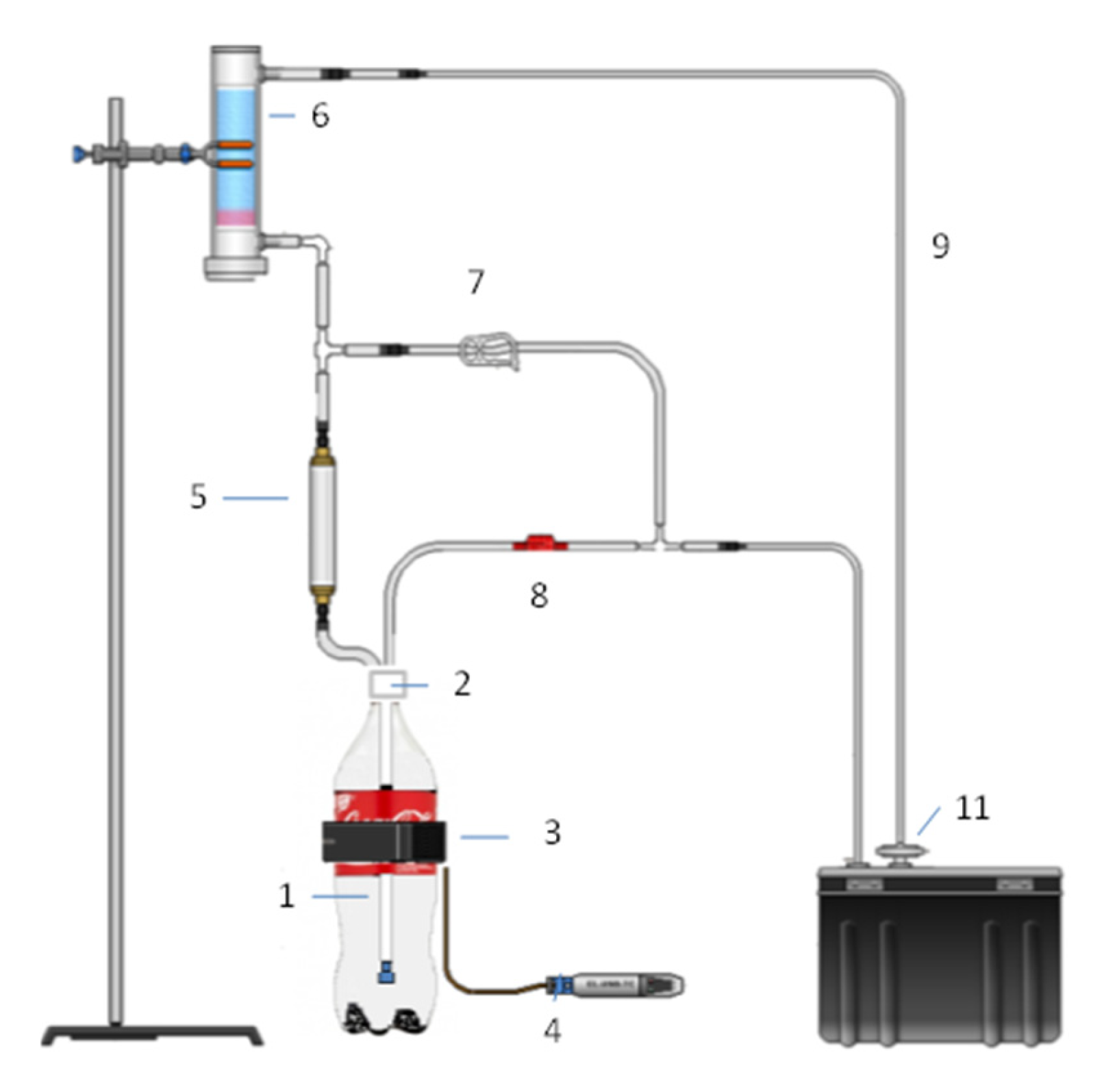
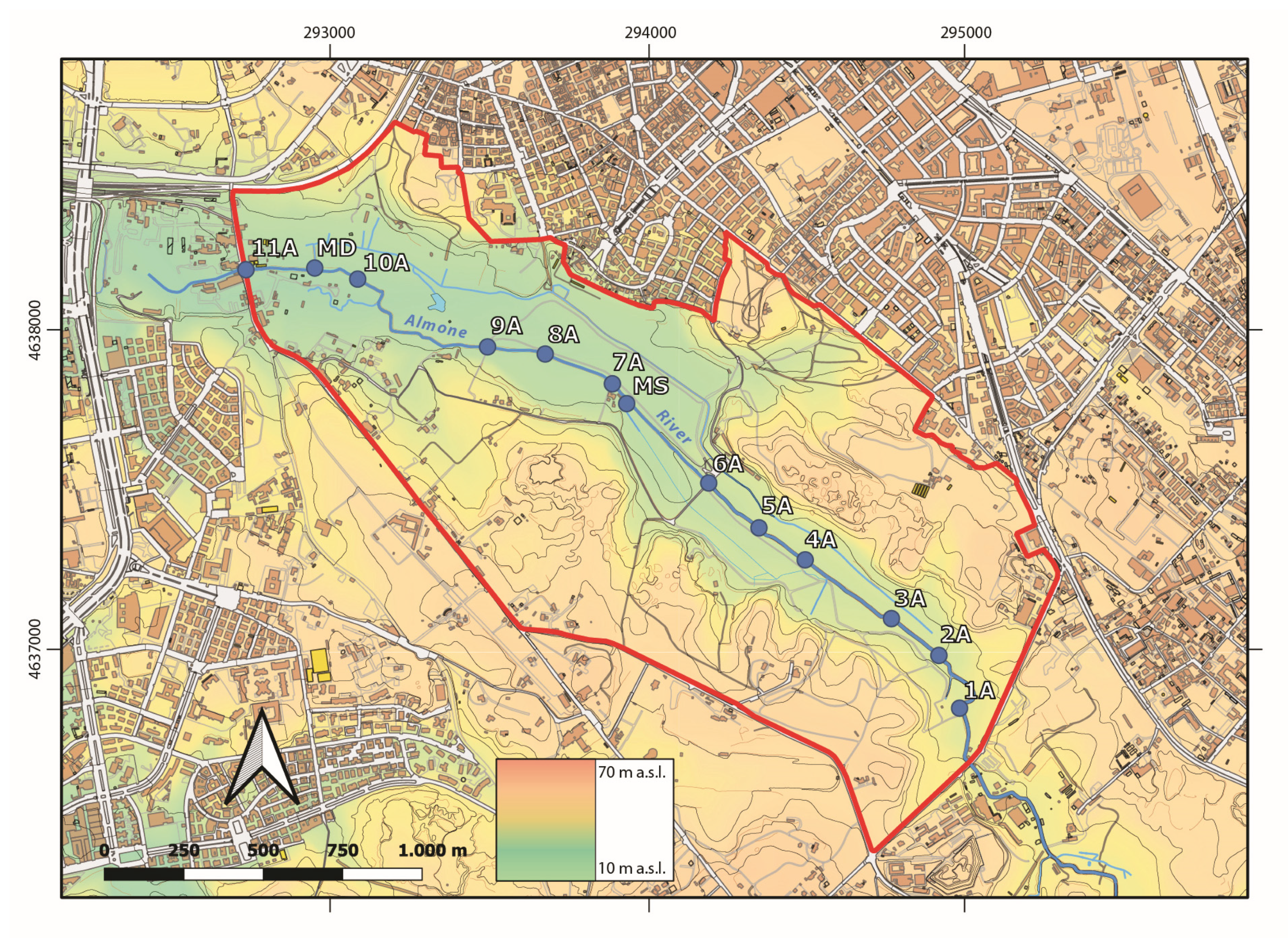
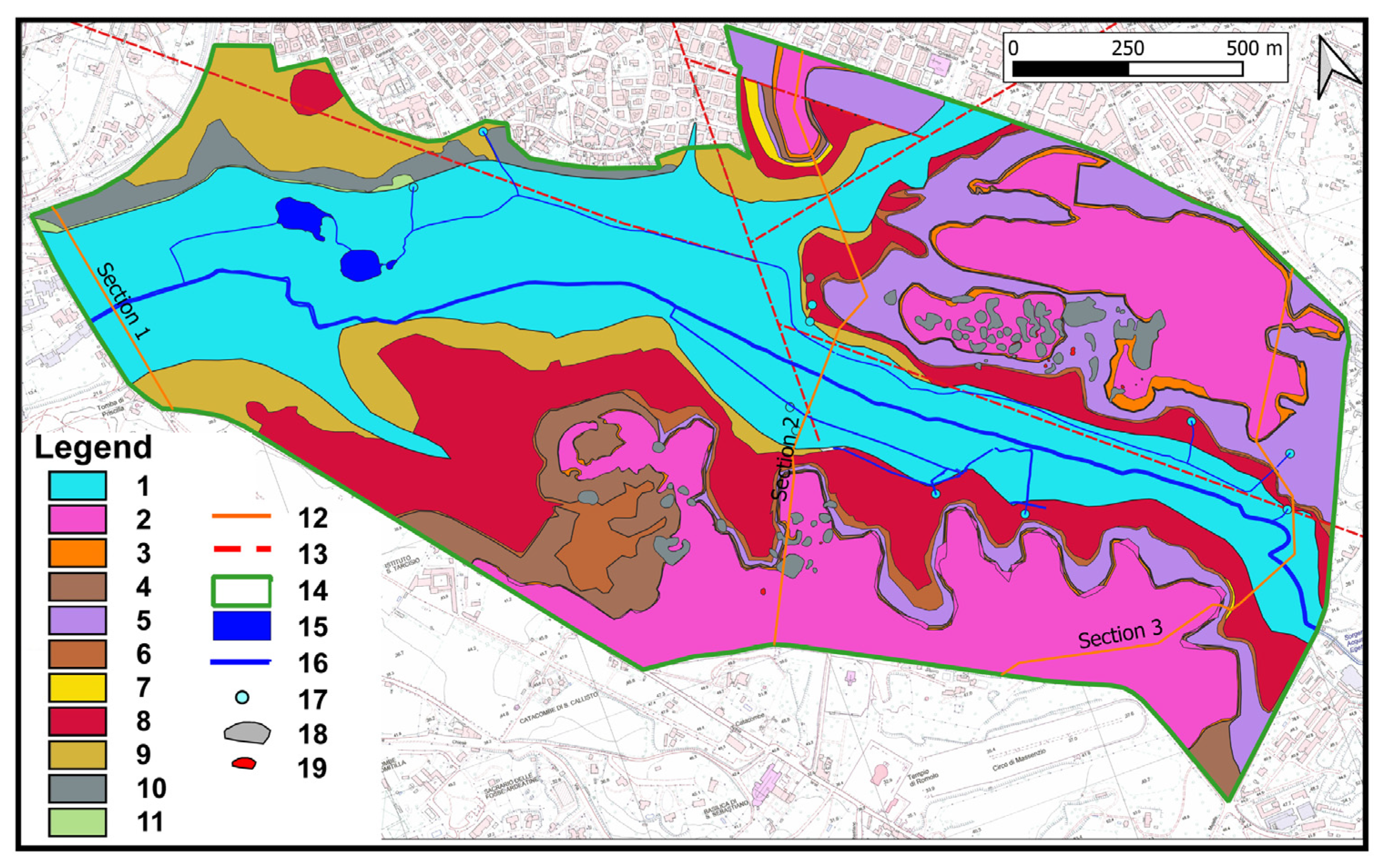

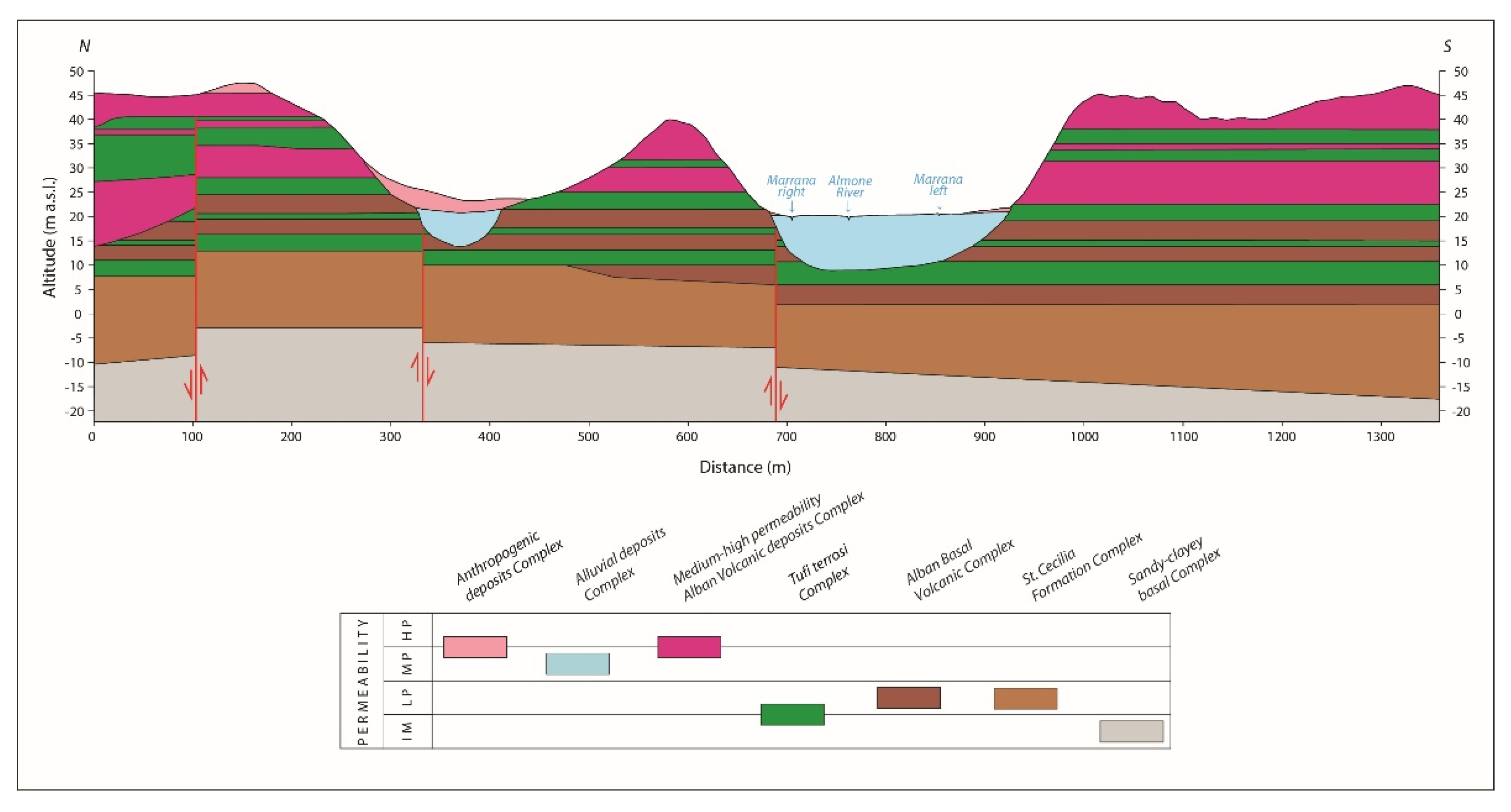
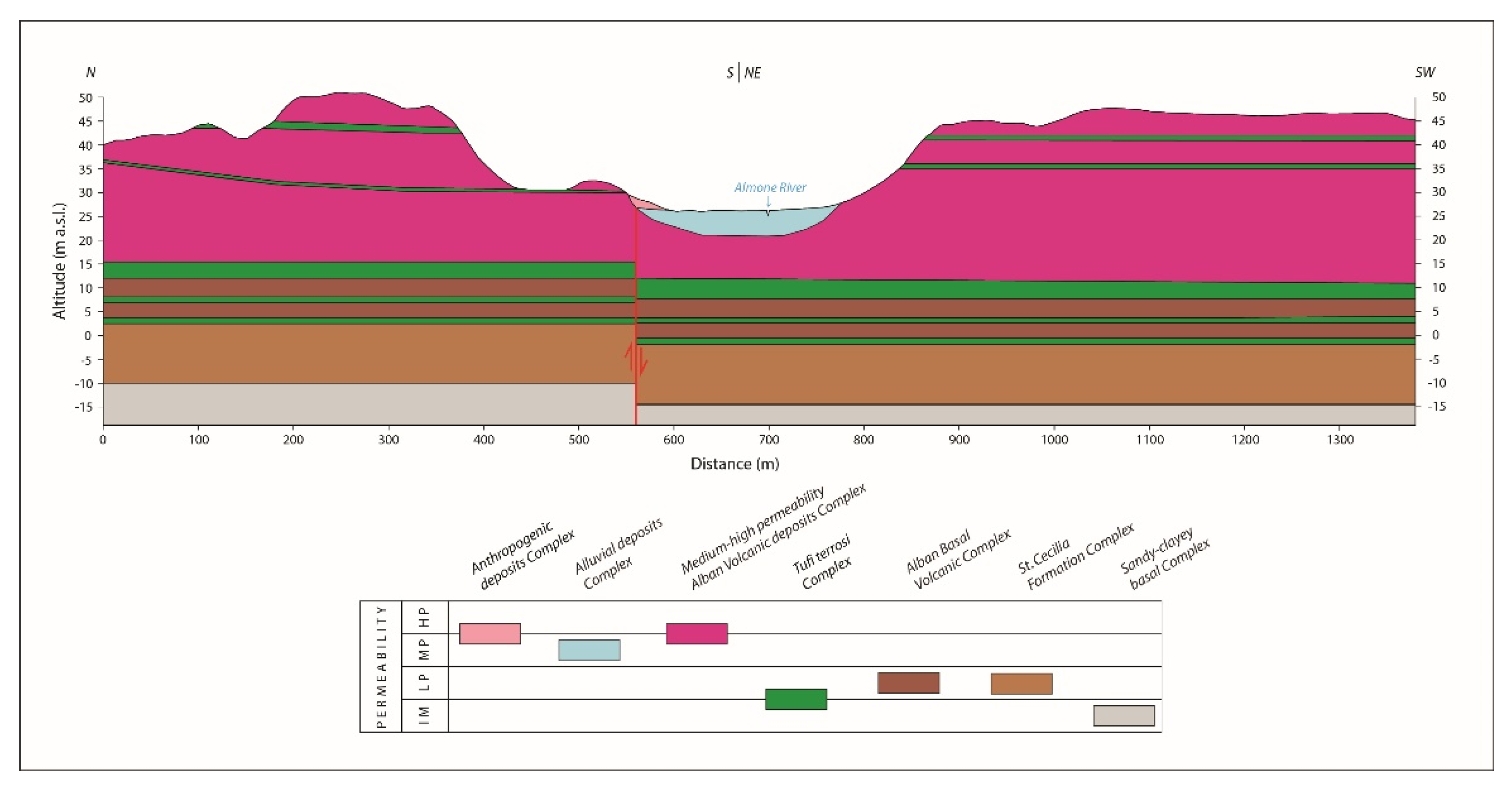
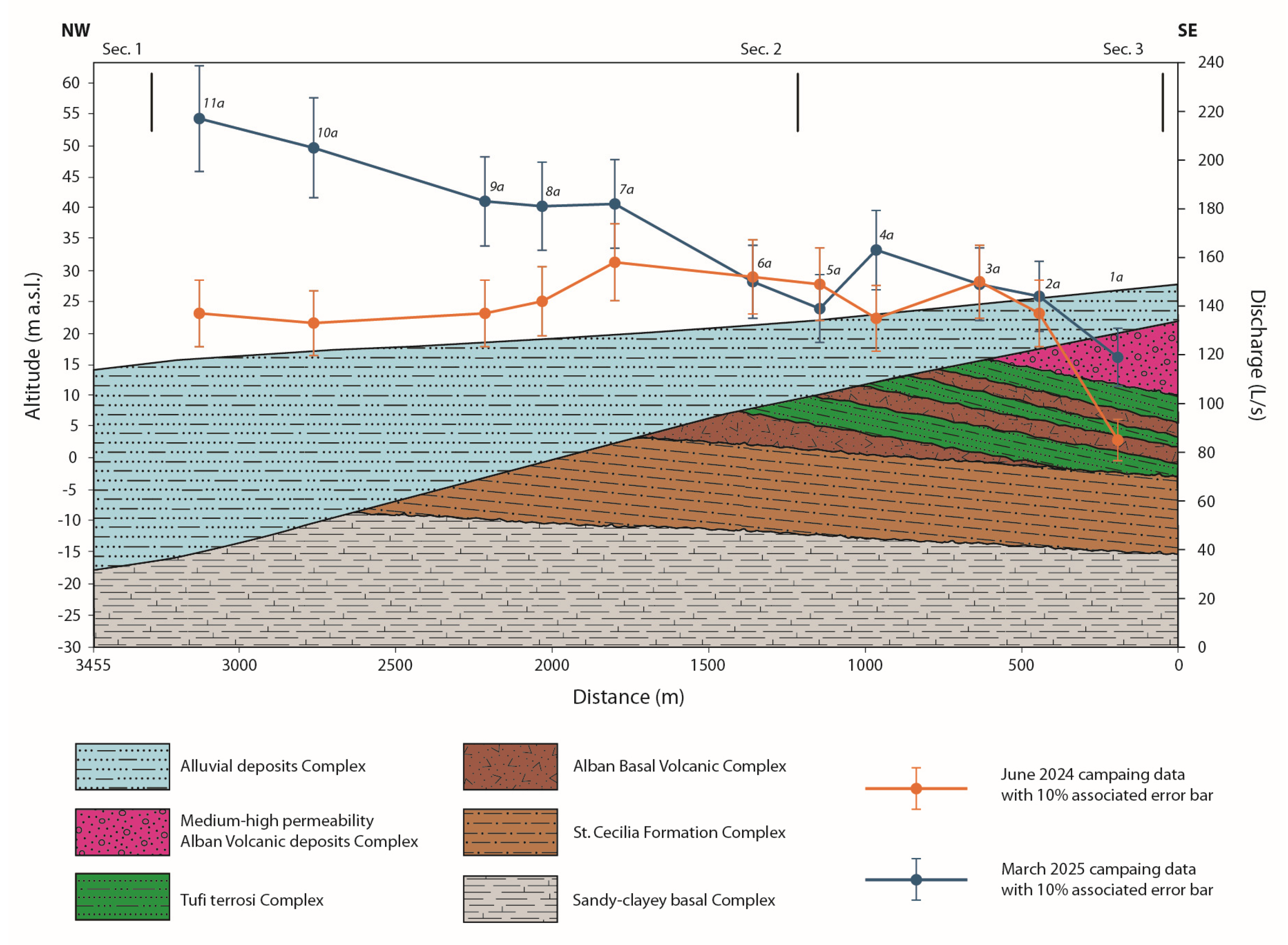
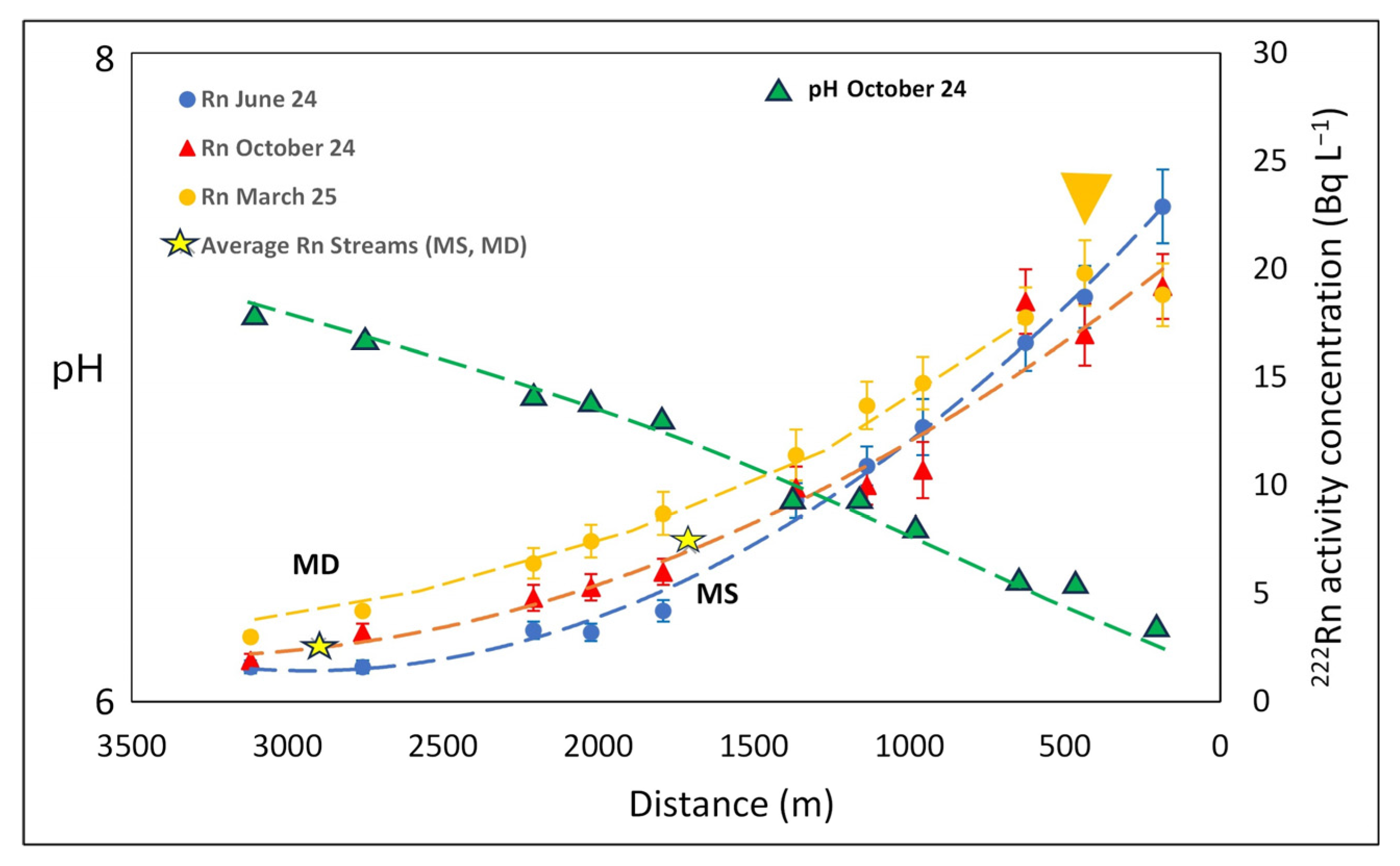
| Site | Discharge (L s−1) * | Discharge (L s−1) * |
|---|---|---|
| June 2024 | March 2025 | |
| 1A | 85 | 119 |
| 2A | 137 | 144 |
| 3A | 150 | 149 |
| 4A | 135 | 163 |
| 5A | 149 | 139 |
| 6A | 152 | 150 |
| 7A | 179 | 195 |
| 8A | 163 | 194 |
| 9A | 158 | 196 |
| 10A | 154 | 218 |
| 11A | 193 | 260 |
| MS | 16 | 13 |
| MD | 21 | 30 |
| Site | 222Rn (Bq L−1) | 222Rn (Bq L−1) | 222Rn (Bq L−1) |
|---|---|---|---|
| June 2024 | October 2024 | March 2025 | |
| 1A | 22.9 ± 1.7 | 19.2 ± 1.5 | 18.8 ± 1.5 |
| 2A | 18.7 ± 1.4 | 17.0 ± 1.4 | 19.8 ± 1.5 |
| 3A | 16.6 ± 1.3 | 18.5 ± 1.0 | 17.8 ± 1.4 |
| 4A | 12.7 ± 1.3 | 10.7 ± 1.3 | 14.7 ± 1.2 |
| 5A | 10.9 ± 0.9 | 10.0 ± 0.9 | 13.7 ± 1.1 |
| 6A | 9.3 ± 0.8 | 9.9 ± 1.0 | 11.4 ± 1.2 |
| 7A | 4.2 ± 0.5 | 6.0 ± 0.6 | 8.7 ± 1.0 |
| 8A | 3.2 ± 0.4 | 5.3 ± 0.6 | 7.4 ± 0.8 |
| 9A | 3.3 ± 0.4 | 4.8 ± 0.6 | 6.4 ± 0.7 |
| 10A | 1.6 ± 0.3 | 3.2 ± 0.4 | 4.2 ± 0.1 |
| 11A | 1.6 ± 0.3 | 1.9 ± 0.3 | 3.0 ± 0.2 |
| MS | 5.1 ± 0.6 | 7.3 ± 0.1 | - |
| MD | 1.8 ± 0.3 | 1.4 ± 0.3 | - |
| Station | October 2024 | March 2025 | ||||
|---|---|---|---|---|---|---|
| T (°C) | EC (μS cm−1) | pH | T (°C) | EC (μS cm−1) | pH | |
| 1A | 18 | 848 | 6.27 | 17 | 830 | 6.55 |
| 2A | 18 | 863 | 6.45 | 17 | 842 | 6.57 |
| 3A | 19 | 860 | 6.45 | 18 | 836 | 6.76 |
| 4A | 19 | 863 | 6.67 | 17 | 841 | 6.60 |
| 5A | 19 | 860 | 6.79 | 17 | 838 | 6.96 |
| 6A | 20 | 853 | 6.79 | 17 | 824 | 6.68 |
| 7A | 19 | 855 | 7.1 | 16 | 825 | 7.01 |
| 8A | 20 | 858 | 7.19 | 17 | 824 | 7.05 |
| 9A | 20 | 855 | 7.2 | 17 | 807 | 7.15 |
| 10A | 17 | 856 | 7.42 | 15 | 805 | 7.16 |
| 11A | 20 | 852 | 7.53 | 13 | 800 | 7.13 |
| MS | 17 | 817 | 7.06 | 15 | 832 | 7.06 |
| MD | 18 | 838 | 7.78 | 14 | 897 | 7.80 |
Disclaimer/Publisher’s Note: The statements, opinions and data contained in all publications are solely those of the individual author(s) and contributor(s) and not of MDPI and/or the editor(s). MDPI and/or the editor(s) disclaim responsibility for any injury to people or property resulting from any ideas, methods, instructions or products referred to in the content. |
© 2025 by the authors. Licensee MDPI, Basel, Switzerland. This article is an open access article distributed under the terms and conditions of the Creative Commons Attribution (CC BY) license (https://creativecommons.org/licenses/by/4.0/).
Share and Cite
Mattia, M.; Mondati, G.; Mazza, R.; Rosa, C.; Di Salvo, C.; Tuccimei, P. Groundwater–River Water Interaction in an Urban Setting (Rome, Italy) Using a Multi-Method Approach (Hydrogeological and Radon Analyses). Water 2025, 17, 1555. https://doi.org/10.3390/w17101555
Mattia M, Mondati G, Mazza R, Rosa C, Di Salvo C, Tuccimei P. Groundwater–River Water Interaction in an Urban Setting (Rome, Italy) Using a Multi-Method Approach (Hydrogeological and Radon Analyses). Water. 2025; 17(10):1555. https://doi.org/10.3390/w17101555
Chicago/Turabian StyleMattia, Martina, Gianmarco Mondati, Roberto Mazza, Carlo Rosa, Cristina Di Salvo, and Paola Tuccimei. 2025. "Groundwater–River Water Interaction in an Urban Setting (Rome, Italy) Using a Multi-Method Approach (Hydrogeological and Radon Analyses)" Water 17, no. 10: 1555. https://doi.org/10.3390/w17101555
APA StyleMattia, M., Mondati, G., Mazza, R., Rosa, C., Di Salvo, C., & Tuccimei, P. (2025). Groundwater–River Water Interaction in an Urban Setting (Rome, Italy) Using a Multi-Method Approach (Hydrogeological and Radon Analyses). Water, 17(10), 1555. https://doi.org/10.3390/w17101555







